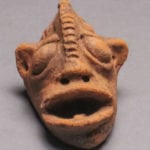 Weird Stuff
Weird Stuff  Weird Stuff
Weird Stuff  Mysteries
Mysteries 10 Tragic Disappearances and Deaths in Joshua Tree National Park
 History
History 10 Ways Childhood Really Sucked in the Old West
 Music
Music 10 Name Origins of Famous Bands from the 1990s
 Religion
Religion 10 Biggest Turnarounds by the Catholic Church
 Weird Stuff
Weird Stuff 10 Unbelievable Times Laws Had Unintended Consequences
 Humans
Humans Ten Historic Women Who Deserve Way More Credit Than They Got
 Movies and TV
Movies and TV 10 Films That Spawned Major Lawsuits
 History
History Ten Times Towns Were Wiped Off the Face of the Earth
 Creepy
Creepy 10 of the Most Disturbingly Haunted Public Houses in the UK
 Weird Stuff
Weird Stuff 10 Niche Subcultures That Are More Popular Than You Might Think
 Mysteries
Mysteries 10 Tragic Disappearances and Deaths in Joshua Tree National Park
 History
History 10 Ways Childhood Really Sucked in the Old West
Who's Behind Listverse?

Jamie Frater
Head Editor
Jamie founded Listverse due to an insatiable desire to share fascinating, obscure, and bizarre facts. He has been a guest speaker on numerous national radio and television stations and is a five time published author.
More About Us Music
Music 10 Name Origins of Famous Bands from the 1990s
 Religion
Religion 10 Biggest Turnarounds by the Catholic Church
 Weird Stuff
Weird Stuff 10 Unbelievable Times Laws Had Unintended Consequences
 Humans
Humans Ten Historic Women Who Deserve Way More Credit Than They Got
 Movies and TV
Movies and TV 10 Films That Spawned Major Lawsuits
 History
History Ten Times Towns Were Wiped Off the Face of the Earth
 Creepy
Creepy 10 of the Most Disturbingly Haunted Public Houses in the UK
10 Fascinating Stories From The History Of The Brooklyn Bridge
It’s one of New York City’s most iconic structures, right up there with the Empire State Building and the Statue of Liberty. Spanning 483 meters (1,595 ft) across the East River and 1,814 meters (5,989 ft) in total, the Brooklyn Bridge is a testament to 19th-century engineering.
Even today, those gigantic pillars, 84 meters (276 ft) tall above the water, are an impressive sight. And if those arches don’t knock your socks off, check out that 26-meter (85 ft) deck suspended by a latticework of crisscrossed steel wires, all hanging from four cables about 38 centimeters (15 in) thick, each made up of 5,434 individual wires. It’s a bridge strong enough to hold 145,000 vehicles each day.
But the Brooklyn Bridge is more than just an amazing architectural achievement. It’s a piece of US history. Once the longest suspension bridge in this world, and repeatedly sold by con men to the gullible, this American monument is full of stories, some inspiring, some tragic, and some downright insane.
10The Winter Of 1867

New York City was a vastly different place in 1867. There was no Chrysler Building, no Yankee Stadium, no Naked Cowboy, and—most importantly—no five boroughs. Up until 1868, Brooklyn, Queens, and Staten Island were their own little cities, totally separate from the Big Apple. Quite a few people living in those towns still worked on Manhattan Island, and that sometimes posed a problem for Brooklynites.
If you want to get from Brooklyn to Manhattan, you have to cross the East River. Back in 1867, there wasn’t a bridge, so folks sailed across on ferries. That was all well and good so long as the boats were running, but every so often, Old Man Winter reared his ugly head and froze the East River solid. The water turned to ice at least five times between 1813 and 1857, and the freeze of ’67 was the last straw. Ships got stuck in the ice, and people seriously had to skate their way to work. It was pretty obvious to everybody—especially those who couldn’t skate—that somebody needed to build a bridge and fast.
9Corruption And A Crushed Foot

German-born engineer John Roebling was already dreaming up plans for a bridge before the winter of ’67. Since the East River was so rough and constantly full of ships, Roebling wanted to build a suspension bridge. Water and boats could easily pass underneath a bridge hanging from four powerful cables. A few palms needed to be greased before construction could begin, but after New York State Senator Henry C. Murphy paid off corrupt politician William “Boss” Tweed, Roebling got busy drawing up blueprints and picking his crew.
Only Roebling never finished the Brooklyn Bridge. In fact, he never even really got started. One day in 1869, he was taking compass readings when he accidentally stuck his foot between a docking ferry and a waterfront piling. The ship slammed into his foot, crushing bones and forcing doctors to amputate his toes. The operation did little good, and just a few days later, John Augustus Roebling slipped into a coma and died of tetanus. The job of building the Brooklyn Bridge fell to his son, Washington Roebling.
8Caissons And The Bends

Just like his old man, Washington Roebling was a master of construction. During the Civil War, he’d built bridges for the Union Army and later helped his dad with the Cincinnati–Covington Bridge. He was up to the task in Brooklyn, which was good news because things were about to get difficult.
The first phase involved setting up the two towers, which had to sit on solid bedrock. Somehow, workers needed to get under the water so they could cut through all that soft mud and lay a granite base. The solution wasn’t fun. Roebling decided his crews would work inside of caissons, giant wooden boxes forced underwater by granite blocks. Pressurized oxygen was constantly pumped inside so workers, nicknamed “sandhogs,” could breathe while they dug and blasted away at the riverbed.
As you might assume, this was all extremely dangerous. The caissons were full of compressed air, and the sandhogs were working with dynamite and gas lanterns. It was a recipe for disaster, and fires broke out on several occasions. On top of all that, it was stiflingly hot, and the workers were prone to headaches and nosebleeds. These sandhogs were definitely earning their two dollars a day.
But while fire was a hazard, the main danger was a mysterious illness dubbed “caisson disease.” It struck without warning, crippling workers with intense joint pain, wild convulsions, and gut-wrenching nausea. Even scarier, sandhogs sometimes found themselves paralyzed. Caisson disease hit over 100 men, claiming several lives and leaving many hopeless invalids.
Things were especially bad in the Manhattan-side tower. While the one near Brooklyn hit bedrock at 13 meters (44 ft), the earth beneath the Manhattan tower kept giving way. So when diggers reached 24 meters (78 ft), Roebling decided it wasn’t worth risking any more lives or money. He called the workers up, hoping the sand was strong enough to support the tower. Fortunately, he was right.
Those caisson workers spent all day working in compressed air. When their shift was over, they rode up to the surface in airlocks so fast that their had no time to adjust. The sudden decrease in pressure caused nitrogen bubbles to dissolve in their tissue and bloodstream, wracking their bodies with violent pain. Today, we know this condition as the bends or decompression sickness.
One of the victims of caisson disease was Washington Roebling himself. The man in charge of the Brooklyn Bridge suffered two debilitating attacks and was left partially paralyzed. Suddenly, the sandhogs needed a new boss.
7The Woman Who Saved The Brooklyn Bridge

It’s almost like the Brooklyn Bridge had a grudge against the Roeblings. Both John and Washington wanted to build it, and both wound up dead or injured. Paralyzed as well as partly blind, deaf, and mute, Washington could only watch the bridge’s construction from his bedroom window using a pair of binoculars. But his mind was still fresh, and his crew needed instructions. How could he get his know-how down to the sandhogs?
That’s where Emily Warren Roebling came in. The two had met at a military dance and married in 1865, and right off the bat, she was plunged into the world of construction. Already planning the Brooklyn Bridge, her father-in-law sent Washington around the world to learn about caissons. Emily went along and got quite an education in bridge-building. And when John died and Washington became the new boss, she taught herself everything relevant there was to know about engineering. More than anything, she wanted to help her husband with his new job. Soon, she got more than she’d bargained for.
With John sick in bed, Emily became his messenger girl. She regularly visited the construction sites, giving the men John’s instructions and carrying questions back to her indisposed husband. However, as time went on, Emily’s role started to change. Soon, workers viewed her as the new boss, and as her knowledge and confidence increased, she effectively became the chief engineer, representing the Roeblings and the bridge to the world. She met with officials, held discussion with engineers, and coached the sandhogs.
And she wasn’t someone you wanted to mess with. When the American Society of Civil Engineers thought about replacing John, she became the first woman to address the group, delivering an impassioned speech in defense of her husband. The committee was awed and decided to keep John—and thus Emily—on the job.
The Brooklyn Bridge took 14 years to build. For 11 of those years, Emily was the one in charge. When it finally opened on May 24, 1883, she was one of the first people to cross the bridge, riding along with President Chester A. Arthur. New York Congressman Abram S. Hewitt told the delighted crowd that Emily Roebling deserved just as much credit as John, who was watching the whole affair from his bedroom window.
Emily led quite a life before her death in 1903. She met Queen Victoria, attended the coronation of Tsar Nicholas II, helped out relief efforts during the Spanish–American War, and even earned a law degree from New York University. And she did all that while taking care of two kids.
6Elephants On The Bridge

By the time the bridge was completed, it had cost approximately $15 million and had claimed the lives of 27 men. In addition to caisson disease, some unlucky sandhogs were crushed under falling equipment. At least one worker was hurled to his death when a cable broke loose and knocked him off his feet.
The deaths didn’t stop when construction finished. On May 30, just a few days after the grand opening, tragedy struck again.
Everyone was still a bit nervous about crossing the bridge. Sure, it was a wonder of modern engineering, but the thing was just hanging over a river while covered with people, horses, and carriages. So when a woman accidentally tripped, someone panicked and shouted, “The bridge is collapsing!” In the ensuing chaos to get off the bridge, 12 people were crushed to death, and 36 were injured.
Hoping to calm everyone down, city officials turned to one of the country’s most famous men: P.T. Barnum. Head of the Barnum & Bailey Circus, P.T. owned one the most iconic animals on the planet, Jumbo the elephant. Barnum proudly declared Jumbo was “the largest known animal in creation,” and city officials wanted Barnum to lead the mighty beast across the Brooklyn Bridge. Always on the lookout for free publicity, Barnum jumped at the chance.
On May 17, 1884, he led a massive parade from Brooklyn to Manhattan. Twenty-one elephants led the way, followed by 17 camels. Bringing up the rear was Jumbo himself, 3.5 meters (12 ft) tall and packing 5.5 metric tons (6 tons) of African power. Ten thousand people showed up to watch this massive creature lumber on by, and after witnessing such a spectacle, everyone was finally convinced the Brooklyn Bridge was safe.
5The First Man To Jump Off The Brooklyn Bridge

In 2013, the tabloids exploded with rage when a woman took a selfie in front of the Brooklyn Bridge—with a jumper in the background. Of course, he was hardly the first to try and end it all by throwing himself into the East River, but not everyone who takes a dive is trying to commit suicide. In 1993, a French daredevil named Thierry Devaux hooked himself up to a bungee cord and successfully jumped off the bridge eight times.
Interestingly, Devaux wasn’t too different from the very first man who leapt off the bridge. Like the Frenchman, Professor Robert Emmet Odlum wasn’t trying to kill himself. In fact, his goal was quite the opposite. By jumping off the bridge, Odlum was actually trying to save lives.
Odlum loved two things: teaching about safety and performing dangerous stunts. One of his biggest concerns was convincing people to jump out of buildings. When buildings caught fire, everybody on the top floor had to leap onto a safety net but many feared this, strangely believing they’d suffocate to death on the way down. Odlum, wanting to disprove this theory, jumped off several bridges to prove his point. And when the Roeblings finished the Brooklyn Bridge, he knew he had to take that plunge into the East River.
Cops weren’t crazy about the plan, and on May 19, 1885, the day of Odlum’s dive, they came out in force. So did the city: Thousands of citizens showed up to watch, and vigilant officers checked every wagon that rolled across the bridge, hunting for the would-be jumper. Odlum had anticipated this and sent a stooge across the bridge to draw the cops’ attention. While they were busy interrogating the decoy, the real Odlum hurried to the railing, raised one of his hands above his head to act as a rudder, and made his dramatic dive.
It did not go according to plan. About 30 meters (100 ft) above the water, Odlum accidentally turned, so he hit the river side-first. The force knocked him unconscious, and a friend was forced to swim to his rescue. After he was hauled onto a nearby boat, Odlum woke up and asked if he’d done well. Those were his last words.
The man immediately started spitting blood. By the time an ambulance arrived, Odlum had died, his ribs broken and his kidney, liver, and spleen all ruptured. Yet he had proven his point. It’s not the fall that kills you—it’s the landing.
4The Cold War Bunker

The 1950s. The Cold War is raging, the Space Race is escalating, and the superpowers are testing nuclear weapons. Across the country, nervous Americans are building shelters in case the Ruskies launch a sneak attack. Even New Yorkers are getting in on the act, ducking and covering and keeping an eye out for the Red Menace. In fact, during the Korean War, floodlights and barbed wire were stretched across the city’s bridges to keep fifth columnists at bay.
Jump ahead to 2006, and the Soviet Union has collapsed. Nobody got nuked, and most New Yorkers have stopped thinking about the Cold War, until a group of workers inspecting the Brooklyn Bridge make a fascinating discovery. Hidden inside one of the structures on the Manhattan entrance ramp is a room full of boxes and barrels. Upon closer inspection, the workers find that a lot of the boxes are marked “For Use Only After Enemy Attack.” They’d stumbled into a Cold War bunker.
The bunker was full of supplies that you’d need to survive the nuclear holocaust. Workers found boxes of medicine, a bunch of blankets, empty metal drums for holding water or serving as toilets, and approximately 352,000 crackers. Almost everything dated back to either 1957 or 1962, the years of Sputnik and the Cuban Missile Crisis, respectively.
Paranoia ran pretty high back then, but these supplies probably wouldn’t have done any good. In 1959, the government determined that if the Soviets dropped two hydrogen bombs on the city, about 6.1 million people would turn into toast. Chances are good the Bridge would, too.
3The Abandoned Champagne Cellars

The Cold War–era bunker isn’t the only secret hidden inside the Brooklyn Bridge. On both sides, hidden under ramps leading to the anchorages, are enormous stone caverns, some reaching 17 meters (55 ft) high. Today, they store maintenance supplies, and from time to time, the occasional vagrant wanders inside and sets up camp. But back when the bridge first opened, these mysterious vaults were lined with rows and rows of champagne bottles.
Hoping to recoup some of the cash they’d sunk into the bridge’s construction, city officials rented these vaults out to wine merchants who needed a place to stash their champagne. The Brooklyn Bridge cellars were the perfect spot for keeping drinks nice and cool, especially as temperature usually stayed around 15 degrees Celsius (60 °F). During Prohibition, the rooms stored newsprint and tools, but as soon as Congress passed the 21st Amendment, the cellars went back in business holding countless bottles.
The cellars hosted some singing parties to go with the endless bottles of bubbly. Guests gathered inside to sip champagne, while bands played music to entertain the revelers. The walls were covered in catchy sayings, some in French, German, and Italian. But others were in English, like the clever motto that reads, “Who loveth not wine, women, and song, he remaineth a fool his whole life long.” And each cellar had its own nickname and persona. For example, one was dubbed the “Blue Grotto,” thanks to a statue of the Madonna who watched partygoers drink and dance.
2The Brooklyn Bridge Shooting
In 2003, a rather incompetent terrorist named Iyman Faris cooked up a crazy scheme to take out the Brooklyn Bridge. This Al-Qaeda Einstein planned on using a blowtorch to cut through every cable holding up the bridge. His plot didn’t exactly pan out. Unfortunately, another terrorist with his eyes on the bridge was much more successful.
A 28-year-old Lebanese native, Rashid Baz was an angry young man who considered himself an “Arab soldier” and kept a cache of weapons in his New York apartment. The guns weren’t for self-defense. After a Brooklyn-born doctor named Baruch Goldstein gunned down 29 Muslims in the West Bank, Baz armed himself to the teeth and went cruising for revenge.
On March 1, 1994, a van full of Hasidic teenagers was crossing over the Brooklyn Bridge when Baz’s Chevy Caprice pulled up behind them. He opened fire with a submachine gun, spraying bullets into the rear window and driver’s side of the van. When his weapon jammed, he pulled out his pistol, shooting until it, too, malfunctioned. Baz wounded three students and murdered a 16-year-old.
After his rampage, Baz and two associates tried to cover up the crime, tossing empty shells and repairing the car’s shattered window. But it was only a matter of time before the cops closed in, and soon Baz found himself in court. After first claiming the whole thing was due to road rage, he pleaded insanity, saying his childhood in war-torn Lebanon gave him a flashback on the bridge. The jury didn’t buy his story and sentenced the Brooklyn Bridge murderer to 141 years behind bars.
1The Brooklyn Bridge Love Locks

Plenty of people associate the Big Apple with romance, and the Brooklyn Bridge is a rather dreamy destination for young couples. Quite a few twitterpated partners have hung padlocks onto the bridge to represent their eternal love.
The locks come in all shapes and sizes, but they all share one similarity. Every padlock bears the name of the couple who locked it onto the bridge. Some lovers write their name with plain old Sharpies while others go to the trouble of blasting their names on with a laser. After the lock snaps shut, the lovers toss the key into the East River, symbolizing their timeless romance. Well, “timeless” until a city employee comes along and hacks the lock off with a pair of bolt cutters.
City officials aren’t keen on the concept. The bridge is a national landmark, so people aren’t allowed to alter it in any way. Plus, the locks could damage the bridge, as it did the similarly decorated Pont de Arts Bridge in Paris. So, two or three times each month, crews haul off buckets of locks. As of March 2014, they’d cleared away nearly 5,600 of them in less than a year. Let’s hope all those lovers are nevertheless still together.
One of Nolan Moore’s big regrets is that he didn’t visit the Brooklyn Bridge the one time he was in New York City. If you want to keep up to date with Nolan’s writing, you can friend/follow him on Facebook. You can also email him here.








